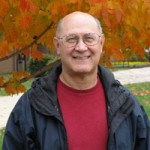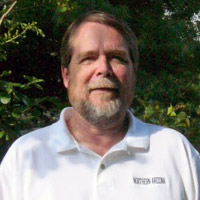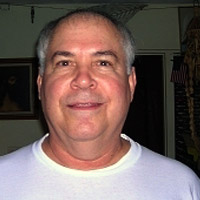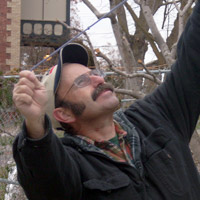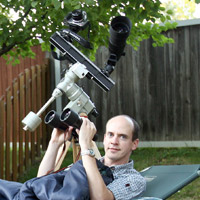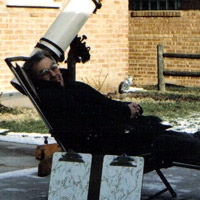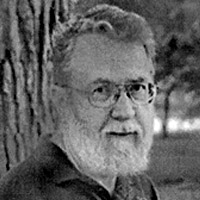Richard Taibi
My interest in space and astronomy was awakened by Sputnik’s launch in 1957. I was 11 then and I bought a 1 1/4-inch refractor, on a flimsy mounting, for $19.95. A dim and shaky image of Venus’ crescent was my first telescopic view. In 1958, my father bought me a 2-inch altazimuth refractor that I used to view Messier objects and double stars as well as the planets. Aperture fever struck me and I moved up to a 3 ¼-inch refractor which I used to sketch lunar formations for a science fair in 1962. My talk, about lunar geology, was the first serious astronomical project I attempted. I considered a college major in astronomy but boring and tedious experiences as a volunteer observatory assistant in 1963 dissuaded me from pursuing a professional astronomical career. And, as a result, I lost interest in astronomy for the next seven years. Astronomy reentered my life in 1970 when my wife and I saw an aurora and an eclipsed moon on the same night. My passion for astronomy was rekindled and I assembled a 4-inch refractor in the next few weeks. I was soon watching planets, sketching Mars during its 1973 opposition, and timing lunar grazing occultations. My first meteor watch was of the 1977 Perseids from Youngstown, Ohio and despite serious light pollution, I found meteors intriguing. However, I only began serious meteor work after I joined the AMS in 1983. The 1985 Perseid display and a brilliant green Taurid fireball the same year made me a confirmed meteor addict. I credit long-time AMS members Karl Simmons, Norman McLeod III, and David Swann for mentoring me in meteor observation. In those days, Karl and Wanda Simmons’ quarterly newsletter Meteor News reported and focused AMS members’ observational efforts and I made many observational contributions to the News. Since 1983, my meteor watches have mainly been from southern Maryland, and its clouds, fogs and mists are frequent sources of frustration. Heavy fog almost made me miss the 1998 and 2001 Leonid storms. Despite weather challenges, I have maintained my enthusiasm for meteor work, most recently by following developments in the Ursids’ hourly rate during the last several maxima. In 1999, curiosity about comet discoverer Lewis Swift led to a fascination with U.S. astronomical history. During a visit with Bob Lunsford in 2000, I mentioned this interest and he suggested that I research and write the AMS’ history. What followed was research at the Library of Congress, Yale University, and the Universities of Pennsylvania and Virginia. A biography of Charles P. Olivier, the AMS’ founder, and a history of 19th Century meteor studies resulted and are posted on the AMS website. My plan for the next few years is to complete the AMS history and to continue meteor watching as well.
Mark Davis
Mark was born in Staunton, Virginia in 1957. His interest in astronomy was a natural outgrowth of the time he spent camping as a child. He acknowledges that a serious interest began with a gift from his father of Peterson’s A Field Guide to the Stars and Planets. Mark would often carry the book up a ladder to the roof of his childhood home where he would scan the night skies with a beat-up pair of 7×35 binoculars.
Mark’s love of the outdoors led him to Fairbanks, Alaska in the summer of 1977. In addition to fighting wildfires, Mark was introduced to the scientific aspect of astronomy when he began assisting University of Alaska astronomers with two different research projects. One project had Mark camping and photographing the Northern Nights, while the other had him making visual estimates of semi-regular variable stars using the university’s refractor.
In December 1988, now living in the Blue Ridge Mountains of Virginia, Mark recorded his first meteor observations, and joined the American Meteor Society and International Meteor Organization. Shortly thereafter he volunteered to index the AMS newsletter Meteor News, reading each issue and learning about the annual meteor showers. In 1995, with interest in email and the internet becoming increasingly popular, a new path for Mark’s interest in meteors emerged.
By chance Mark encountered fellow meteor observer George Zay online and the two began discussing coordinating their observations – Mark from the east coast and George from the west coast. Their efforts worked so well from the start that they decided to look for other observers they could set up coordinated watches with. Out of these first efforts, the North American Meteor Network (NAMN) was established in 1995.
Mark has served as the coordinator of NAMN since its founding, publishing meteor reports, recruiting new observers and providing them with guidance on how to carry out meteor watches. Over the past fourteen years NAMN has grown to become truly international with over 500 members worldwide residing in 36 different countries. Mark has also volunteered his time assisting the AMS, IMO as well as the ALPO Meteor Section and has served in one or more positions for these meteor groups.
In addition to his meteor observing, Mark also spends time observing binary stars and star clusters. He has recently developed an interest in the lunar surface and its various features and is beginning to study it with his refractor. Mark has been employed by the National Park Service as a park ranger for nearly 26 years.
Kim Youmans
Astronomy has always been a great interest of mine as far back as early childhood, when I can recall lying under the stars on warm South Georgia nights as young kid, trying to fathom their great distances. At age ten, I was treated to the March 1970 solar eclipse, and since the path of totality was only a few miles from my hometown, I recall watching in awe as the street lights came on and almost total darkness filled the sky – I was completely hooked on all things astronomical. I spent many nights trying to memorize various constellations and many days bugging my teachers about which planets might be visible during a given night.
As a late teen, while “cruising” with a close friend one Friday night, I was treated to a fireball that dropped quite slowly directly on the horizon in front of us, spewing sparkly fragments and lasting two or three seconds. I was inspired enough to learn about the various showers, and from that year forward always made attempts to catch the Perseid meteor shower each August, though inclement skies seemed to prevail as often as not, and I generally didn’t know for many years that the radiant wasn’t up until late evening.
Still, I was treated to quite a few earth-grazers over those years and during clear nights the shower never disappointed, as say, Halley’s comet did – having bought a small telescope but finding the tiny ghost of an image nothing like the hyped predictions.
The great Perseid rates of the early nineties coincided with my college years, and having greater access to both popular and academic references to the return, I finally learned to stay up all night and was at last truly observing a meteor shower in all its glory. The ’93 return was cloudless and was the best meteor show I had yet to witness, topped off by an very bright fireball with a 1- 2 minute train, having an intense electric neon-blue color the likes if which I have yet to see repeated despite the several thousand meteors I have observed since.
With the advent of the internet and the approaching return of the Leonid peak years, I jostled my way into the meteor observing community and through constant questioning on the Meteorobs mailing list, and the weekly NAMN internet chats, developed and began honing my observing skills. In 1999, I went out and observed every possible night in a diligent attempt to be a good observer and hopefully use those skills for any possible Leonid “storm” I might have the great fortune to catch. My diligence did finally pay off in ’97, ’98, and, of course, especially in 2001 and 2002.
My offer to work as a volunteer for the AMS was taken up by Bob Lunsford and in 2003 I became the AMS Visual Program Coordinator, and while I was not able to get out and observe on the schedule I had set for myself a few years earlier, I still managed to be a year-round observer and my passion for all things meteoric has never abated. I currently split my time living in both Atlanta and the small sleepy hamlet of Swainsboro, Ga, and given work and health considerations, I must extend a warm, gracious thanks to Bob for stepping in and pulling up my slack this past year and I fully hope to resume year-round observing and report-gathering in 2009.
Robert Lunsford
Bob has been interested in the stars as far back as he can recall. His parents placed his crib next to the window as he enjoyed seeing the moon and stars. He began telescopic observing back in the early 60’s with a 2″ refractor on a flimsy six inch tripod. He had to stack the patio chairs three high to see anything high in the sky. His first experience with meteors was a biggie, the 1966 Leonid shower. He knew when Leo would rise and woke shortly after. Unfortunately this was before the peak of the display and the few meteors he did see were nothing like the possible storm mentioned on the news broadcast the previous evening. Only when he came across the February 1967 issue of Sky & Telescope did he realize what he missed. For the next decade and an half he faithfully followed the major showers each year reporting his results to Sky & Telescope. He began dark sky meteor observing in 1974, viewing the impressive Perseid and Orionid displays from that year.
In 1980, a major awaking occurred. He received a sample copy of Meteor News. He was amazed to learn there was a group actually devoted strictly to meteor observing! He joined the group also started to view some of the minor showers list among the pages of Meteor News. 1988 saw the creation of the IMO and he was proud to become one of the founding members. This was a great opportunity to correspond with meteor observers worldwide. Also in 1988, David Levy resigned as Recorder of the ALPO Meteors section and Bob eagerly filled that position.
In 1999 Bob joined the IMO expedition to Spain to view the Leonid storm. He was also part of the ground team that observed the 2001 Leonids from Mt. Lemon. That November morning produced the most impressive meteor display he has witnessed with rates peaking at 35 Leonids per minute. The following year Bob joined Dr. Peter Jenniskens on the Multi-Instrument Airborne Campaign and witnessed both Leonid peaks that year through intensified goggles as the jet flew from Spain to North America.
Currently Bob spends his free time trying to keep up with the demands of three meteor groups. The AMS takes up most of his time as fireball reports and video data arrives on a daily basis. He has recently set up an intensified video camera to record the activity on all clear nights. Since he works for the local newspaper from 2-10am this allows him to still monitor the skies while at work.
He still likes to monitor the skies telescopically using a 6″ refractor, a 9.25 SCT, and a 16″ reflector. He especially likes to photograph the planets using video frames and stacking software. He tries to get out to dark skies at least once a month to view the fainter objects not well seen from home.
Lastly, he was contracted by Springer Publishing in 2007 to write a book on observing meteors. The book should be available in 2009 and hopefully will be a useful guide to all interested in the enjoyable field of meteor observing.
Norman McLeod III
Norman McLeod was born in Miami, Florida in 1946. A 4th-grade science unit began his interest in astronomy. By the end of 8th grade he had a good working knowledge of the constellations and began meteor observing in the summer of 1960. The Miami sky was still quite dark into 1961.
Meteor work was limited by school until 1971. Then Norman began an extensive year-round observing effort choosing when possible to live in areas with easy access to excellent skies. By early 1976 he had seen at least one meteor on each of the 366 calendar nights. From 1971 to 1981 he recorded at least 3700 meteors each year, peaking in 1974 with 7146 meteors and no showers missed. In mid-August 1981 the weather made a permanent turn for the worse — quite cloudy much of the time. Only 1996 since then was a good year. The best season used to be summer but it changed to winter after the mid-1990’s. The cobalt skies of Florida vanished into semi-permanent hazy conditions, still plenty of heat and sun for tourists but almost worthless for astronomers.
Norman observes using some old couch cushions. With a paved surface most of the time a ground cloth has been largely unneeded. A handful of cold nights require heavy clothes but most nights are balmy. For mosquitoes he uses a cardboard fan and repellent or burning coils if the bugs are numerous. By the mid-1980’s he gave up using a tape recorder after having 3 of them each last only a year before breaking. He folds paper in 4ths lengthwise and writes in the dark without a light, then holds the paper keeping a finger on the next spot to write.
During the years 1963 to 1981 Norman went to the Florida Keys for the best possible observing conditions: black skies, warm nights, and sometimes no mosquitoes while an old bridge was available. Norman has observed through 2 peak Leonid epochs and hopes to see a 3rd. He saw the Geminids grow from a Perseid rival in the 1960’s to the best regular shower in the 1970’s. The biggest surprise was the 1982 Lyrids peaking at 5 meteors/minute.
In the years since 2000 Norman’s observing has fallen on hard times. The rapid city growth ending dark skies with costlier travel on congested roads has reduced him to observing only for the best showers. His observing record spans 48 years with about 90000 meteors recorded. The outlook for surpassing 100000 is not good.
Norman’s other interests include car travel around the U.S., weather, most other science, economics, finance, most types of music, theology, non-textbook history, and geo-political trends. He has been a tax preparer for 15 years and is an Enrolled Agent.
Mike Morrow
Mike Morrow came into this world on August 24, 1937 in Philadelphia. Pa. When he was still a young boy the family would visit friends and family and return home late in the evening. His Mom would often say “Oh a shooting star”, Mike never saw a shooting star. But while in high school he has a science project and decided to make a telescope. He went to the Franklin Institute and on some nights after the Planetarium show he would go up to the roof to look through the telescopes there. One evening he actually saw a shooting star. That was the beginning. He would go to the Flower Observatory and view through the 18 inch scope there and he met Dr. Charles P. Oliver. Dr. Olivier got him interested in observing meteors. It was really neat doing things with Dr. Olivier!
Mike graduated from high school and Dr. Olivier retired from University of Pennsylvania and moved to Narberth. Mike would go over to Dr. Olivier’s house a few times a week and would talk and he would share his astronomical wisdom. Mike eventually joined the Navy and would send some observations to him from where the ship was in the North Pacific Ocean. After the Navy, while Mike attended U Penn for one semester. He would go over to his house and see the thousands of meteor cards in his basement. Dr. Olivier hired Mike to work on recording data from the cards. Mike would go over on Tuesday and Thursday evenings for two hours. He told Mike he was paying him more than he ever paid anyone else. Mike received one dollar an hour. Some evenings they ended up playing chess with no pay and Mike never won a game.
Mike moved to Hawaii in 1961 and started observing meteors many nights a month. It was great! The Weather Service, where Mike then worked, soon transferred him to the Arctic. He tried to observe there, but at 70.8 degrees north, 24 hour daylight interfered during the summer and aurora messed things up in the winter when it was dark. From the Arctic Mike was transferred to the Arizona Desert. It was hot but got dark during the summer but at least he was able to observe meteors.
When Mike returned to Hawaii he started the Meteor Group Hawaii with a few others from the Hawaiian Astronomical Society. They have done visual and radio meteor observations. Mike now lives on the Big Island of Hawaii where it is dark but there is no power nearby. He soon hopes to have radio observation equipment going again soon. Other than getting old and finding temperatures of 40 through 50 degrees quite cold, Mike feel that life and observing here is great.
Robin Gray
Robin Gray was born in Spokane, Washington in 1950. By age six he had developed a strong interest in both insects and Astronomy. He clearly remembers the beginning of the space program and the excitement of it. He read every book available to him on Astronomy and was particularly interested in Mars. During the early 1960’s he began to read Sky and Telescope, which he has continued to this day. Summer nights spent sleeping outside led to his first experience with meteors.
However, due to the mistaken idea that there was nothing that the amateur Astronomer could contribute to the field he did not get into the observational end of the activity. During the seventies preoccupation with school and living overseas kept astronomy limited to reading. In 1983 he returned to the U.S. and moved to Nevada where he purchased 7×50 binoculars and began observing a few celestial objects such as comets. During early morning commutes to Reno through the dark Forty Mile Desert he saw many spectacular meteors and this greatly increased his interest in them. In 1995 he read Neil Bone’s book “Meteors” and realized for the first time that it was possible for an amateur to contribute to a branch of astronomy. His first systematic observations of meteors took place on October 20, 1995, and shortly after that he joined ALPO, the AMS and the IMO and began spending many nights out observing meteors.
Robin observes from a reclining deck chair and uses a -20 degree sleeping bag, as nights in Northern Nevada can drop well below zero on occasion. He bundles up with hood and gloves in summer as well because of mosquitos, which he finds more distracting than frigid nights. He uses the pen and paper method of recording data except under storm conditions, when a tape recorder is employed. He clips a digital watch to the clipboard so that the time is easily accessible when recording meteors.
Robin observes meteors during the entire year as he considers that data from all times, from major showers to dearth in February and March, to have value. He enjoys the deep solitude of the small hours of the morning, when everyone but night creatures are sleeping. There is a strong spiritual side to observational astronomy besides the scientific aspect. He also contributes observations to ALPO’s Lunar Transient Phenomenon program.
Other interests and preoccupations are Entomology, human evolution and religion, human prehistory, and the Baha’i Faith. He runs his own business doing mosquito and blackfly abatement.
Pierre Martin
Pierre Martin was born in Ottawa, Ontario in 1976. As a child, his interest in astronomy stemmed gradually from a natural curiosity and fascination with the heavens above. At the age of 10, Pierre spent a clear summer evening in his backyard, intent on finding out how many satellites and “shooting stars” he might be able to count before his bedtime. It was a rather uneventful watch but by a stroke of pure luck, near the end, a dazzling fireball streaked high above, leaving behind a thick train lasting several seconds. There is no question that this event sparked the beginning of a long-lasting interest in astronomy, and particularly with meteors. In the following few years, the early bedtimes and school homework did not deter Pierre from “sneaking out” unseen by mom or dad, in the wee hours of the night (or in the case of cold weather – snuggling up close to a bedroom window) – to see what the Orionids, Geminids and Ursids were up to. His diligence and patience under less-than-optimum conditions at the time rewarded him more than once.
Pierre’s first serious meteor session (where detailed notes were taken) was held in August 1988. Unlike many other observers’ beginnings, the Perseids were not meant to be his first shower (Pierre had made plans to setup in his backyard to view the predawn 1988 Perseids, only to wake up after sunrise due to a failed alarm clock). Instead, he found out about a minor shower called the Kappa Cygnids that were due to peak just a few nights after the Perseids. A very clear night materialized on the evening of August 20. In about two hours, he witnessed a few possible KCG, but the real jaw-dropper was an extraordinarily slow-moving object, which was seen fragmenting many times over the span of several seconds (the probable result of a rare Russian artificial satellite re-entry above the Great Lakes). To this day, this remains the most spectacular and dramatic “fireball” that Pierre has ever seen.
Pierre has been actively recording meteor shower data, and submitting his observations to IMO, ALPO, AMS and NAMN every year since 1994. His passion was further fueled by the Perseid enhancements of the 1990’s. His most impressive Perseid display came on the morning of August 12 1997, a shower he witnessed with fellow meteor observer Cathy Hall. A sharp peak occurred before dawn when he recorded 121 PER in one hour TEFF including many bright meteors! Pierre then closely followed the much anticipated Leonid epoch between 1998-2002. The dazzling 1999 and 2001 meteor storms (as seen in Spain and West Virginia, USA respectively) are events that he will never forget. Pierre’s most intense and exciting observation was the display of November 18, 2001. Observing all night under a pristine 7.1 magnitude sky, he recorded 3412 Leonids (of which included 16 bolides ranging from magnitude -6 to -10). His best single five minute period just before dawn had a count of 138 meteors! This event was for Pierre “a meteor observers dream come true”.
To this day, Pierre’s primary interest continues to be visual meteor observing. He can be found on a regular basis at dark skies spanning an hour or two’s drive around Ottawa. Pierre’s most recent expedition was a last-minute 1800km car trip to Tennessee to catch the 2006 Geminids. Pierre’s basic observation tools include a comfortable recliner, a tape recorder, a talking clock, a clip board (to plot meteor paths on IMO’s Gnomonic charts) and a small variable red light. Winters in the “Great White North” are known to be bitterly cold, so Pierre resorts to some creative ways to make the experience more comfortable. He has a portable “meteor coffin” (a custom-built box made of foldable plywood sheets and topped with aluminum blankets) that surround his lawn chair and sleeping bag. This not only keeps Pierre sheltered from the worse of the elements while trapping a layer of warmth inside, but can also help shield his eyes against direct light pollution. During those crisp bone-chilling winter nights the “coffin” makes all the difference!
Pierre often combines his visual sessions with photography (he uses equatorially-mounted automated DSLR cameras). His interest in astronomy is not limited to meteors. He enjoys the deeper skies with his 12.5″ Portaball telescope, and he is also actively involved with various public astronomy outreach.
Pierre’s other interests include nature photography, reading, writing, diving and camping. He is currently employed at the Canada Agriculture Museum as a graphic designer, and he continues to reside in Ottawa, Ontario.
Bill Watson
Bill Watson was born in Buffalo, New York, in 1943 and became very interested in astronomy by 1950. Having moved to Kenmore, a suburb of Buffalo, he was not favored with dark skies and spent most of his time reading the astronomy books in the public library and later learning the major constellations. After reading Fletcher Watson’s Between the Planets he became most interested in comets, asteroids and meteors. For his eighth grade science project he studied the April- June 1957 apparition of Comet Arend-Roland; however, he was more impressed by Comet Mrkos three months later. When no comet was available at the appropriate time for his ninth grade science project he documented the asteroid 7 Iris, which reached 6.9 magnitude October 25, 1957. He has continued observing asteroids and has currently has observed 323 of them.
Like most meteor observers the August Perseids sparked his early interest in meteor observing. At one point he asked for maps to plot meteors from the AMS and C. P. Oliver sent him a note in green ink asking him to first submit some hourly counts for the Perseids. Unfortunately conditions were so poor the counts were never sent in to the AMS. Although he lost some of his early records, he still has all his records going back to July 29, 1957. For each meteor he recorded the shower, magnitude, constellations the meteor passed through, time, and remark such as color, speed, etc. When meteors were more than 20/hr. only counts would be made.
If the Perseids sparked an interest in meteors, the Leonids created a bonfire, and at the turn of the century Bill went on a quest to fulfill his life long ambition of observing a meteor storm. The 1998 predicted peak at November 17 19h favored the Western Pacific and Asia. So Bill and his wife spent three weeks in Kyoto, Japan, awaiting the “storm.” Considerable time was spent trying to find an observatory or suitable observation site. After unsuccessfully obtaining permission to view meteors at the University of Kyoto Observatory it was decided that a Buddhist Temple on top of a remote mountain would make an excellent place to observe meteors. So they drove the Hieizan Highway to Enryaku-ji Kaikan (only stopping once for directions) and joined a multitude of Buddhist faithful, who went to this temple to be rejuvenated. The temple consisted of about thirty buildings and Bill had some difficulty finding the hotel. After seemingly endless (but very small) courses of soups, tofu, rice, seaweed and other vegetarian delights Bill waited for 1:00 AM local time to be escorted to the chosen observing site. Unfortunately even Buddhists believe in security light, and the skies became cloudy, and less than 200 meteors were observed that night. There were some bright fireballs and an excellent shower, but not the anticipated storm.
For 1999 the initial predicted Leonid peak was November 17 at 23h UT, which favored site in the Near East and Mizpeh Ramon in the heart of the Negev Desert in southern Israel was chosen as the destination – no chance of any clouds there. In the two weeks he was there, Bill did not see one cloud. A fifteen minute drive south of Mizpeh Ramon was Carpentry Hill (in the middle of the Machtesh Crater) which had a parking lot less than a half mile from the summit. Once atop Carpentry Hill Bill realized as he watched car after car fill up the parking lot below, that he was not the only one that thought this location was the best spot to observe the shower. With a limiting magnitude 6.35 most of the night, Bill had a spectacular night. Between 1:59:10 and 2:09:20 UT, 541 meteors (a rate of 3,193 meteor/hour) were observed. Overwhelmed by the breathtaking display many in the crowed broke into Israeli songs. At last Bill felt he could die happy.
As most of you probably know Buffalo, NY is notorious for its lake effect snow and clouds, so Bill continues to search for clear skies, and in recent years has gone to the Hawaiian Islands and Fanning Island (in the Republic of Kiribati) for the Geminids and Portal, Arizona, for the Orionids.
Robert Hays Jr.
Robert H. Hays, Jr. was born in 1950 and has always lived in the Chicago area. He became interested in astronomy as a boy, which he ascribes as “probably out of curiosity for natural phenomena. He began watching meteors during the 1960’s; especially vivid in his memory is a brilliant Perseid fireball in 1965. The Chicago light pollution exploded in the 1960s and ‘70s, and most of his observing involved the moon, lunar occultations, and planets.
His best meteor observing began in 1976 when he began watching in darker semi-rural sites. The first of these watches was on January 4, 1976 when he saw 33 Quadrantids in one hour with the temperature at –2 degrees F. It is no surprise that the Perseids have been his biggest draw; he saw an excellent display in 1980, with rates of about 80/hr. He saw several other good displays during the eighties, but states, “…the August weather has been mostly poor since then.” Most of his recent success with the Perseids has been due to traveling in search of better weather – a meteor observer tradition for many of us!
His observing is often catch-as-catch can, due to variable weather. As a result, he is often found out on nights with no major showers. A true meteor aficionado, Robert will often go out “just to see what meteors there are – and sometimes I’m pleasantly surprised! There are often night sounds that add to the ambiance. Depending on the season and locale there are owls, peepers, whip-or-whills, crickets, and other sounds that I can’t always identify.”
Most of Robert’s meteor observing is done at the various Indiana Fish & Wildlife areas just across the state line from Illinois. “They have decent skies despite being less than 75 miles south of Chicago. I do occasionally go on camping trips in rural areas and mix in some meteor observing, so I have observed at a variety of sites.”
Robert loves the simplicity of meteor observing. “I just need a chaise lounge, blanket, notebook, or clipboards. Most of the time he just counts meteors and gathers basic data. He only plots when low meteor activity is expected; even then he sometimes gets more than he bargained for! A useful “invention” for making things easier in the field is a “meteor board” consisting of two clipboards attached to a piece of paneling.
The short-wave radio is often used for timekeeping “since checking a watch can take longer than plotting.” .” He uses a tape recorder for strong sessions – “…absolutely essential during the 2001 Leonid display.” At that shower’s peak, he averaged about 8/minute with spikes to about 12/minute “despite it being a humid night with a fog threat – it clouded over shortly afterward. I saw more meteors that night than I have ever seen in a year!
You should be able to spot Robert’s “meteor board” in the photo, with his telescopes in the background. Robert uses large framed-glasses while observing to see more of the sky, but he’s only mildly myopic. Still, he sees the stars best when wearing them. Having recently retired from the U.S. Postal Service after 32 ½ years, Robert plan on observing for as long as he can!
George Gliba
George Gliba was born in Cleveland, Ohio in 1948, and lived in the small town of Chagrin Falls, (20 miles SE of Cleveland) before moving to Maryland in 1979 to work at the NASA/Goddard Space Flight Center. His love of astronomy began with a fireball sighting during a 1959 camping trip. His first meteor shower observation was the 1961 Perseids, seeing 59 meteors in three hours. George has been a true mainstay with the AMS, having joined back in 1963. Only a year later, in ’64, George had plotted over 500 meteors in 57.65 hours. In 1967 he had his best Perseid rates ever, at 103 per hour.
As George joined the USAF in the late ’60s, through the mid-70’s – as an Aerospace Control & Warning Operator – his meteor observations waned considerably. He began observing again during the 1986 Eta Aquarids for the International Halley Watch. He has continued to be quite active since that time. His best meteor shower hourly rate (not ZHR) was the 2001 Leonids, when he saw 750 Leonids and 6 sporadics in one hour from Mathias, West Virginia. That same night, he estimated the magnitude of 1,681 meteors in four hours. “A difficult but rewarding task, especially the last hour!” In 1998, he saw 23 Leonid fireballs in 3 hours and 15 minutes, from the slopes of Mauna Kea, Hawaii, which he stated was “.an unforgettable experience!” No doubt!
George is also interested in variable stars, comets, and deep-sky observing. He has seen 30 supernovae, 76 comets, and 16 novae along with all of the Messier Objects and many Herschel Objects. George has 14 telescopes, including a 20-inch Dobsonian with wife Lynne Gilliland, who is also an avid amateur astronomer.
George is currently a Senior Technical Specialist at the NASA/Goddard Space Flight Center, Greenbelt, Maryland, where he has worked as a contractor on several satellite projects since 1979. He has been employed with the company SP Systems Inc. since 2000. He also enjoys collecting meteorites, Natural History, bicycling and Buddhism.
Paul Martsching
We begin the first in a series of AMS observer profiles with a short article on perhaps the most prolific observer in the recent history of the AMS. Born in Ottumwa, Iowa in 1946, Paul Martsching was already observing aurora and comets in the dark skies of Wapello County as a preteen. His passion for observing these objects, in addition to meteors, has not waned. It was during these earlier years that Paul witnessed the brightest meteor event of his life — a fragmenting, red/orange fireball the diameter of the moon! His first shower, the 1964 Perseids, were observed from atop his parents garage. He counted 55 PER in 45 minutes!
A long meteor-drought began for Paul, as inclement weather seemed to be the rule during most, if not all, of the Perseid maxima for many years thereafter. He was rewarded in 1980 with exceptional rates (94 PER’s in a single hour period) while observing with the Ames Area Amateur Astronomy Club. Although he would miss the Perseid maxima over the next several years, Paul finally began to observe meteors in earnest in 1987, offering his first reports to the AMS that same year.
Like a few other observers, Paul has special, over-sized lenses in his “astro-glasses†using only distance correction. He prefers the pen-and-paper method of observing, and suggests that a sleeping bag can be quite useful even in warm weather, — as a mattress-pad.
Paul has made some interesting observations; such as the outburst he witnessed the night of August 18, 1988, when 15 meteors appeared from a rough radiant near RA 20H 25M +36 in just over a four-hour period. He’s also endured some frigid weather while observing, e.g., the windy Geminid maximum of 1985 when his local temperature dropped to –8 degrees F! With the incredible number of observing periods and nights logged over the years, Paul has surely made an enduring contribution to amateur meteor astronomy.
 American Meteor Society
American Meteor Society
